Celebrating Iwo Jima Monument and D.J. Wilkins’ restoration on Veteran’s Day and Marine Corps’ 100th anniversary
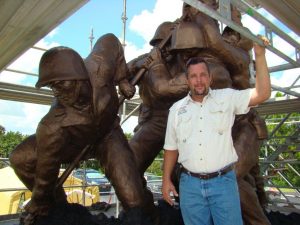 In addition to casting more than 23 original sculptures and sculptural installations throughout Lee County, the late Don Wilkins restored the Tootie McGregor Fountain in the parking lot of the Fort Myers Country Club, The Spirit of Fort Myers at the McGregor Boulevard entrance to Edison Park and the Iwo Jima Memorial in Cape Coral. He was most proud of the latter effort.
In addition to casting more than 23 original sculptures and sculptural installations throughout Lee County, the late Don Wilkins restored the Tootie McGregor Fountain in the parking lot of the Fort Myers Country Club, The Spirit of Fort Myers at the McGregor Boulevard entrance to Edison Park and the Iwo Jima Memorial in Cape Coral. He was most proud of the latter effort.
The latter 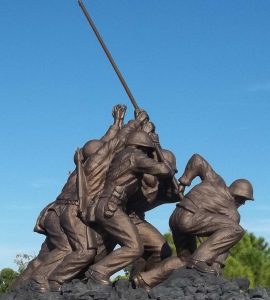 artistic landmark was commissioned by Leonard and Julius Rosen for the Rose Garden, a Cypress Gardens/Sea World-like theme park they built at Tarpon Point to entertain the prospects the brothers enticed to the subdivision they were creating in Cape Coral in the early 1960s. When the park closed in 1970 amid rising expenses and flagging attendance, the Memorial was abandoned and quickly fell into disrepair. But a decade later, the statue was moved to a bank on the corner of Del Prado Boulevard and Viscaya Parkway, which engaged the sculptor to restore the sculpture to its former
artistic landmark was commissioned by Leonard and Julius Rosen for the Rose Garden, a Cypress Gardens/Sea World-like theme park they built at Tarpon Point to entertain the prospects the brothers enticed to the subdivision they were creating in Cape Coral in the early 1960s. When the park closed in 1970 amid rising expenses and flagging attendance, the Memorial was abandoned and quickly fell into disrepair. But a decade later, the statue was moved to a bank on the corner of Del Prado Boulevard and Viscaya Parkway, which engaged the sculptor to restore the sculpture to its former 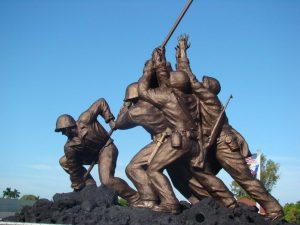 majesty.
majesty.
In 1998, the statue was moved to its permanent home in the Four Mile Cove Ecological Preserve known to locals as Eco. Following its relocation, Wilkins was hired to make some additional repairs to the installation. But a second, even more intensive restoration became necessary in 2011 after decades of ultraviolet sunlight, intense heat and high humidity and 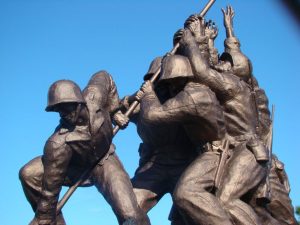 rainfall and winds from Hurricane Charley caught up with the hollow concrete landmark. Go here to read the fascinating account of the sculpture’s 2011 restoration.
rainfall and winds from Hurricane Charley caught up with the hollow concrete landmark. Go here to read the fascinating account of the sculpture’s 2011 restoration.
Notwithstanding a subsequent encounter with an errant motor vehicle, the Iwo Jima Memorial today greets commuters as the cross the Midpoint Memorial Bridge. Soaring 20 feet into the Florida sky, the statue 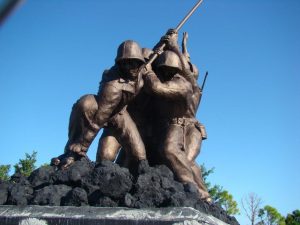 depicts five Marines and a Navy hospital corpsman raising the American flag on 560-foot Mount Suribachi, the highest point on Iwo Jima, a small island located 660 miles south of Tokyo. Many think that it is a replica of the 60-foot-tall Iwo Jima Memorial near Arlington National Cemetery in Virginia, but it is, in fact, one of three originals that were created by renowned sculptor Felix de
depicts five Marines and a Navy hospital corpsman raising the American flag on 560-foot Mount Suribachi, the highest point on Iwo Jima, a small island located 660 miles south of Tokyo. Many think that it is a replica of the 60-foot-tall Iwo Jima Memorial near Arlington National Cemetery in Virginia, but it is, in fact, one of three originals that were created by renowned sculptor Felix de 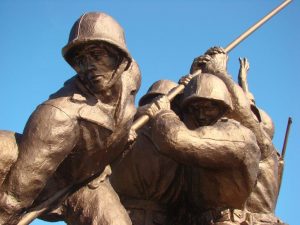 Weldon.
Weldon.
De Weldon was inspired to sculpt the memorial located in Arlington after seeing AP photographer Joe Rosenthal’s Pulitizer Prize-winning picture of the actual flag raising that took place on February 19, 1945. “The photograph came in to the War Department on a Thursday,” Wilkins explained at the time of the 2011 restoration. “De Weldon immediately saw in the photo a sculpture, and he started a model of 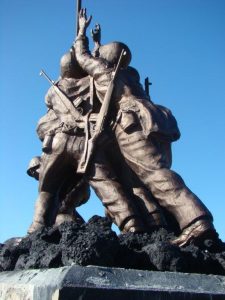 the statue the next day. He finished it on Monday and showed it to [then Vice-President] Harry S. Truman on Wednesday.” That mock-up (known as a maquette) eventually won him a commission to create the 60-bronze that has stood just outside the Arlington National Cemetery on the southern shores of the Potomac River since its installation in September of 1954.
the statue the next day. He finished it on Monday and showed it to [then Vice-President] Harry S. Truman on Wednesday.” That mock-up (known as a maquette) eventually won him a commission to create the 60-bronze that has stood just outside the Arlington National Cemetery on the southern shores of the Potomac River since its installation in September of 1954.
Depicted are Pfc. Rene A. Gagnon, Pfc. Ira Hayes, Pharmacist Mate Second Class John Bradley, Pfc. Harlon Block, Sergeant Mike Strank and Pfc. Franklin Sously. Block, Strank and Sously died within days of the flag raising in combat on the IJM 5northern end of the island. De Weldon sculpted them using their photographs and measurements. Hayes was 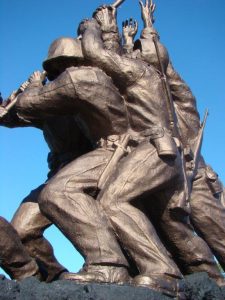 also sent to the northern end of the island and was wounded in a mortar attack. But he survived, as did Gagnon and Bradley. All three survivors modeled for de Weldon’s tribute to all Marines who have died in action since 1775.
also sent to the northern end of the island and was wounded in a mortar attack. But he survived, as did Gagnon and Bradley. All three survivors modeled for de Weldon’s tribute to all Marines who have died in action since 1775.
The Battle of Iwo Jima holds the dubious distinction of being one of the bloodiest in the Pacific Theater during World War II. Between February 19 and March 26, 1945, 6,821 American lives were lost and another 20,000 men were wounded. That represented more than a third of the 70,000 man invasion force and was the only battle in the Pacific Theater in which American casualties outnumbered those of the 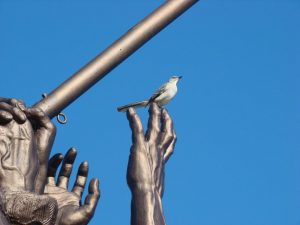 Japanese. Only 216 of the 22,000 Japanese soldiers on the island when the battle began were taken alive. The rest either died in action or committed suicide. But it is the iconic image of five Marines and one Navy hospital corpsman raising the American flag on 560-foot Mount Suribachi that has come to symbolize the sacrifices made by these men during the five-week campaign.
Japanese. Only 216 of the 22,000 Japanese soldiers on the island when the battle began were taken alive. The rest either died in action or committed suicide. But it is the iconic image of five Marines and one Navy hospital corpsman raising the American flag on 560-foot Mount Suribachi that has come to symbolize the sacrifices made by these men during the five-week campaign.
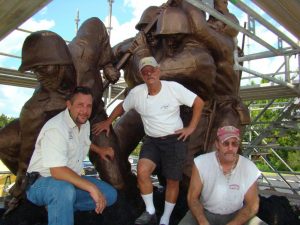 Wilkins drew pride and satisfaction each Veterans Day that Cape Coral’s Iwo Jima Memorial yet endures. DJ would have especially celebrated the Iwo Jima Monument this year as it falls one day following the 100th anniversary of the Marine Corp’s creation on November 10, 1921.
Wilkins drew pride and satisfaction each Veterans Day that Cape Coral’s Iwo Jima Memorial yet endures. DJ would have especially celebrated the Iwo Jima Monument this year as it falls one day following the 100th anniversary of the Marine Corp’s creation on November 10, 1921.














 Tom Hall is both an amateur artist and aspiring novelist who writes art quest thrillers. He is in the final stages of completing his debut novel titled "Art Detective," a story that fictionalizes the discovery of the fabled billion-dollar Impressionist collection of Parisian art dealer Josse Bernheim-Jeune, thought by many to have perished during World War II when the collection's hiding place, Castle de Rastignac in southern France, was destroyed by the Wehrmacht in reprisal for attacks made by members of the Resistance operating in the area. A former tax attorney, Tom holds a bachelor's degree as well as both a juris doctorate and masters of laws in taxation from the University of Florida. Tom lives in Estero, Florida with his fiancee, Connie, and their four cats.
Tom Hall is both an amateur artist and aspiring novelist who writes art quest thrillers. He is in the final stages of completing his debut novel titled "Art Detective," a story that fictionalizes the discovery of the fabled billion-dollar Impressionist collection of Parisian art dealer Josse Bernheim-Jeune, thought by many to have perished during World War II when the collection's hiding place, Castle de Rastignac in southern France, was destroyed by the Wehrmacht in reprisal for attacks made by members of the Resistance operating in the area. A former tax attorney, Tom holds a bachelor's degree as well as both a juris doctorate and masters of laws in taxation from the University of Florida. Tom lives in Estero, Florida with his fiancee, Connie, and their four cats.